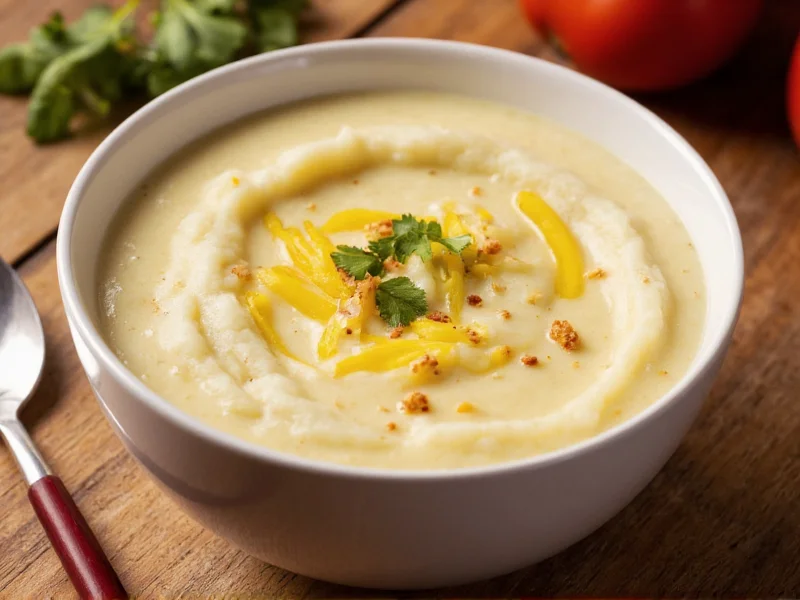The Essential Mashed Potato Soup Foundation
Creating exceptional mashed potato soup starts with understanding its core components. Unlike regular mashed potatoes, this soup requires careful liquid-to-solid ratios to achieve that perfect spoon-coating consistency. The magic happens when starchy potatoes meet flavorful broth and just enough dairy to create velvety texture without heaviness.
Professional chefs emphasize using day-old mashed potatoes when possible. This unexpected technique allows starch molecules to retrograde, resulting in soup that maintains body without becoming gluey. If starting from raw potatoes, russets provide the ideal starch content, while Yukon Golds offer natural buttery notes that reduce needed dairy.
Ingredient Breakdown: Quality Matters
Each component plays a critical role in your creamy mashed potato soup recipe. Substitutions can work, but understanding each ingredient's purpose ensures better results.
| Ingredient | Function | Pro Tips |
|---|---|---|
| Russet potatoes | Provides starch for thickening | Peel completely - skins create graininess |
| Chicken/vegetable broth | Flavor base and liquid component | Use low-sodium to control salt levels |
| Heavy cream | Creates luxurious mouthfeel | Substitute with evaporated milk for lighter version |
| Butter | Enhances flavor and smoothness | Unsalted allows precise seasoning control |
| Garlic powder | Depth without raw garlic bite | Add during cooking, not at end |
Step-by-Step Preparation Guide
Follow this method for foolproof mashed potato soup from scratch. The process takes approximately 45 minutes with minimal active preparation time.
- Prepare potatoes: Peel and dice 2 pounds russets into uniform 1-inch cubes. Place in cold salted water, bring to boil, and cook until fork-tender (15-18 minutes).
- Create flavor base: While potatoes cook, sauté 1 diced onion and 2 minced garlic cloves in 2 tablespoons butter until translucent.
- Combine elements: Drain potatoes thoroughly, then add to onion mixture with 4 cups warm broth. Simmer 5 minutes to meld flavors.
- Texture development: Using a potato masher (not blender), partially mash potatoes to desired chunkiness. Over-processing creates unappetizing glue.
- Final enrichment: Stir in 1 cup room-temperature cream and 1/4 cup grated Parmesan. Season with white pepper and chives.
Avoiding Common Mashed Potato Soup Mistakes
Even experienced cooks make these critical errors when preparing potato soup:
- Cold dairy addition: Adding refrigerated cream causes curdling. Always warm dairy to room temperature first
- Over-seasoning early: Salt concentration changes as liquid reduces. Season in stages, finalizing after cream addition
- Using waxy potatoes: Red or fingerling potatoes don't provide necessary starch for proper thickening
- Skipping potato drying: Excess water from boiling dilutes flavor and prevents proper thickening
Variations for Every Dietary Need
Adapt this basic recipe for different preferences while maintaining that essential creamy texture:
For dairy-free mashed potato soup, substitute coconut milk for cream and use olive oil instead of butter. The natural sweetness of coconut complements potatoes surprisingly well. Add 1 tablespoon nutritional yeast for cheesy notes without dairy.
Transform leftovers with mashed potato soup with bacon by stirring in 1/2 cup crumbled cooked bacon and 1/4 cup chopped chives. The smoky saltiness balances the soup's richness perfectly.
For healthy mashed potato soup options, replace half the potatoes with cauliflower. This reduces carbohydrates by 30% while maintaining creamy texture. Use Greek yogurt instead of cream for added protein.
Storage and Reheating Best Practices
Proper storage maintains quality for future enjoyment. Mashed potato soup thickens considerably when refrigerated due to starch retrogradation.
Store in airtight containers for up to 4 days. When reheating, add small amounts of broth or milk to restore original consistency. Never microwave without stirring frequently - the starches separate unevenly. For best results, reheat gently on stove over medium-low heat.
Freezing changes texture significantly due to potato starch behavior. If freezing is necessary, omit dairy before freezing and add fresh cream when reheating. Expect slightly grainier texture but acceptable flavor.
Nutritional Profile and Serving Suggestions
A standard 1.5-cup serving contains approximately 280 calories, 14g fat (8g saturated), 32g carbohydrates, and 6g protein. The soup provides 25% of daily vitamin C needs and 10% of iron requirements.
Pair with crusty bread for dipping or a simple green salad for balanced nutrition. For elegant presentation, top with chive oil (blend 1/4 cup olive oil with 2 tablespoons chopped chives) and a sprinkle of smoked paprika.
Perfecting Your Technique
Mastering mashed potato soup requires understanding how ingredients interact. The starch in potatoes absorbs liquid differently based on temperature and agitation. Professional kitchens often prepare a roux first for extra stability, but home cooks achieve excellent results by controlling potato cooking time and dairy temperature.
For restaurant-quality presentation, strain the soup through a fine-mesh sieve after partial mashing. This removes any fibrous bits while maintaining body. Finish with a swirl of truffle oil or roasted garlic puree for special occasions. Remember that the simplest versions often taste best - focus on quality ingredients rather than complicated techniques for truly satisfying mashed potato soup.











 浙公网安备
33010002000092号
浙公网安备
33010002000092号 浙B2-20120091-4
浙B2-20120091-4